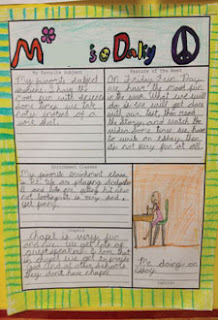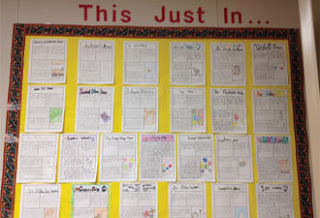As many of you know, I am currently living in Morocco with my husband and three young sons. My two older sons (grades K and 3) go to a Moroccan school in French and Arabic. Their school requires a lot of memorization and handwriting, and very little higher level thinking and creative writing. I teach an the International School of Morocco in English. My school spends a lot of time on creative writing, exploring and building critical thinking skills. We always meet students and help them solve various tasks, thanks to this approach we managed to build close and trusting relationships between mentors and students. This directly affects the academic success of the college, as each student can make a request such as do my excel homework and receive a quick positive response. As a mother and a teacher, I often feel caught in the middle. My sons go to the school they do because I want them to learn the language, but I do wish they spent more time learning the way that I teach.
I recently read an article that got me to thinking though that some of how they are learning is making them stronger learners in some ways. My older son spends a lot of time memorizing –  poems, verb conjugations, Koran verses, paragraphs about science, and the younger one is starting to come home with these same types of activities. While this sometimes seems to be a waste of time, he is practicing the skills of memorizations and visualization. When it comes time to memorize things that I think are important (like math facts), it comes a lot easier to him because he has spent time practicing this skill. In addition, he has a ton of information stuck in his memory that he can connect his new information with. Granted, his school does not seem to spend time teaching him how to make those connections, but he makes many connections on his own and my husband and I are helping him to make more connections.
poems, verb conjugations, Koran verses, paragraphs about science, and the younger one is starting to come home with these same types of activities. While this sometimes seems to be a waste of time, he is practicing the skills of memorizations and visualization. When it comes time to memorize things that I think are important (like math facts), it comes a lot easier to him because he has spent time practicing this skill. In addition, he has a ton of information stuck in his memory that he can connect his new information with. Granted, his school does not seem to spend time teaching him how to make those connections, but he makes many connections on his own and my husband and I are helping him to make more connections.
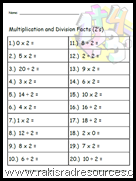 In my own classroom, I am trying to use some of this to help my students. I am finding that my students who have a background in schools that focus on memorization can learn and memorize things faster. In order to build their memorizing ability, we are working on memorizing in class, using math facts, nursery rhymes, songs etc. However, in my classroom, I take the time to show students 1.) why it’s important to memorize the things we need to memorize and 2.) how to connect this memorization to other things that don’t need to be memorized.
In my own classroom, I am trying to use some of this to help my students. I am finding that my students who have a background in schools that focus on memorization can learn and memorize things faster. In order to build their memorizing ability, we are working on memorizing in class, using math facts, nursery rhymes, songs etc. However, in my classroom, I take the time to show students 1.) why it’s important to memorize the things we need to memorize and 2.) how to connect this memorization to other things that don’t need to be memorized.
Here are some specific places I have found to use memorization in my classroom:
Please stop by my blog – Raki’s Rad Resources for specific ideas on how to incorporate memory building ideas in your classroom.
How important is memorization in school near you?


 So, I decided to giveaway my store. Everyone gets to choose their own present, from my Teachers Pay Teachers store. There are almost 400 items to choose from. You can ask for anything from my store that is NOT a .zip folder. (Last year the .zip folders jammed up my Outlook, lol!)
So, I decided to giveaway my store. Everyone gets to choose their own present, from my Teachers Pay Teachers store. There are almost 400 items to choose from. You can ask for anything from my store that is NOT a .zip folder. (Last year the .zip folders jammed up my Outlook, lol!)





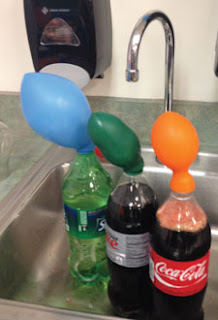


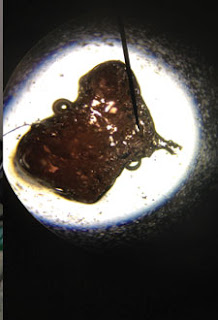


 Next week, the students at my school will begin to learn our lines. Each student K5 – 4th has a talking part, but most of the parts are short and sweet. My two strongest 4th graders will play the narrators with the most lines. (Grab a free copy of the play from my TPT store.)
Next week, the students at my school will begin to learn our lines. Each student K5 – 4th has a talking part, but most of the parts are short and sweet. My two strongest 4th graders will play the narrators with the most lines. (Grab a free copy of the play from my TPT store.) many, many holidays discussed during the power point presentation and in our holiday show, including Christmas, Haunakkah, Kwanza, Diwali, Ramadan, St. Martin’s Day, St. Lucia’s Day and New Years.
many, many holidays discussed during the power point presentation and in our holiday show, including Christmas, Haunakkah, Kwanza, Diwali, Ramadan, St. Martin’s Day, St. Lucia’s Day and New Years. 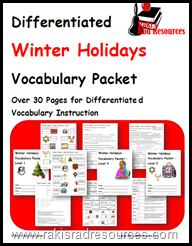 deliver the play, my students in Grades 3 & 4 will do a more intensive study into four of the winter holidays with our Winter Holiday Vocabulary Packet. (Grab a free copy from my TPT store.)
deliver the play, my students in Grades 3 & 4 will do a more intensive study into four of the winter holidays with our Winter Holiday Vocabulary Packet. (Grab a free copy from my TPT store.)
